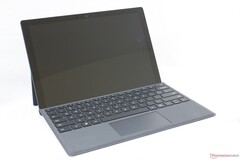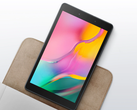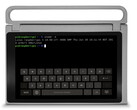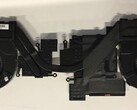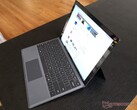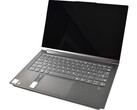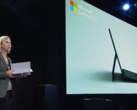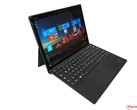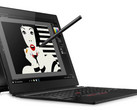When looking for a powerful device running Windows, a tablet is probably the last thing on your mind. However, there are professional artists who use tablet PCs for work. Microsoft’s advertising for their Surface Pro tablets often mentions this use case specifically, implicitly suggesting that their tablets are more powerful than their form factor might lead you to believe. Being able to run a quad-core processor at laptop-like speeds might seem insane, but it’s more likely than you think.
While there are some Windows tablets that use ultra-low power Intel CPUs, there are many tablet PCs using the same processors as traditional laptops. The obvious benefit of this is the added performance this brings to such a small form factor. Being able to use power-hungry applications without worrying about lag is the goal, and there are both laptops and tablets that can provide that experience. However, the laws of thermodynamics still apply to tablets. While you are using more powerful chips, they generate significantly more heat than their lower-power counterparts. In essence, you trade low case temperatures for more performance.
For the sake of consistency, we’ll mostly be looking at stress tests when considering performance. While this data could arguably be irrelevant to every-day usage, stress test data can provide meaningful insight into how capable the thermal solution of any given device is. Of course, our reviews will be linked in the article when a device is mentioned so you can check any benchmarks there if you’d like. Often, stress test data follows any performance gains or losses you’d find in a benchmark score. If you’re looking for dedicated details on how thermals affect performance on mobile hardware, you can read my previous article here.
Addressing the previously mentioned Surface Pro, we’ll look at the recently reviewed Surface Pro 7, specifically the Intel i5-1035G4 variant. This tablet performs the same both on battery and when plugged in, and the performance it gets is quite impressive. The Surface Pro 7 draws roughly 17.5 watts consistently (2.5w over TDP) while maintaining core temperatures around 60 °C. This is all without a single fan to be found, but that comes at a cost. After 30 minutes of heavy load, the Surface Pro 7 on its back was 42 °C on average with some spots reaching nearly 48 °C (108 °F to 118 °F). The front was around 3 °C cooler than the back, but temperatures were still quite high.
If you’re thinking that this heat from sustained load on a tablet isn’t exactly realistic, think again. Many programs used by professionals can be quite demanding, and a long session might result in the tablet reaching similar temperatures to our stress test. Without active cooling, that heat in the heatsink could remain for some time after an intense load has stopped, keeping the casing warmer for longer. With a fan, the heatsink could be cooled down rapidly, allowing the case to cool faster in the process. A hybrid cooling system (where a passive and active cooling approach is used) could benefit both core and case temperatures. There aren’t any tablets that currently do both well.
On the (mostly) actively cooled side of things, consider the Lenovo ThinkPad X1 Tablet Gen 3. Despite having an Intel i5-8250U (compared to the Surface’s i5-1035G4), this 2018 tablet manages to outperform the Surface Pro 7 by 3% (17cb) in the Cinebench R15 multi-core test. If Lenovo improved the power management on the X1 Tablet, it could likely score higher on benchmarks (current scores fluctuate from high to low rapidly).
CPU temperatures averaged around 80 °C at 17.5 watts with case temperatures on the back averaging around 40 °C, only reaching around 49 °C near the exhaust vent. The front averaged 2 °C cooler than the back, reaching about 44 °C near the exhaust. It’s important to keep in mind that ambient temperatures were 2 °C higher when the X1 Tablet was tested, putting it at a disadvantage when it comes to case temperatures.
The Surface Pro 7 easily takes the lead for graphical performance with its Intel Iris Plus Graphics, which easily beat out the Intel HD 630 Graphics found on the old ThinkPad X1 Tablet. If you need graphics performance and don’t want to deal with a potentially bulky docking solution, the Surface might be a better option.
At the same time, a Lenovo Thunderbolt 3 Graphics Dock could be used for a slim and convenient solution for on-the-go graphics performance. This dock contains a desktop-level NVIDIA GTX 1050, which easily outperforms Intel Iris Plus Graphics. This dock would have to be purchased via a third party since Lenovo no longer sells it. However, if you’re willing to spend the extra money, the Graphics Dock might be a worthwhile addition to your bag.
If you prioritize serviceability over zero fan noise and graphics performance, the X1 Tablet might be for you. The Surface features an on-board/non-removable SSD whereas the X1 Tablet features an easily replaceable SSD in an M.2 slot. Since storage is often one of the first major components to fail in a computer, having the part be easily replaceable will only increase the device’s lifespan, as well as easier data recovery in the event of a nasty drop. The X1 Tablet also has the option for a WWAN card whereas the Surface Pro 7 does not.
It’s important to remember that the performance you’re getting from these tablets is nowhere near the limit of a similarly sized laptop. For instance, the slightly bigger Dell XPS 13 7390 2-in-1 blows these tablets out of the water in both of our stress test scenarios. When running FurMark and Prime95, the 2-in-1 maintains about 23.5w on the CPU, while the CPU package temperature averaged about 75 °C. Due to the difference in core count, it would be unfair to compare these laptops via benchmarking. Regardless, a 6 watt difference between systems can (and will) result in a lot more performance.
Overall, high-performance tablets probably should have fans. Something like a performance mode that would enable the fans could allow for greater power consumption, overall increasing the performance of these small machines. A hybrid passive-active cooling system could work, but it’s important to note that high core temperatures could possibly result in incredibly uncomfortable case temperatures.
With the recent entry of vapor chamber cooling into the 2-in-1 laptop market (for example, the previously mentioned XPS 13 2-in-1), it’s possible that we’ll be seeing large improvements in tablet performance from this cooling tech. The impressive thermal performance the XPS 13 2-in-1 achieves with a vapor chamber cooler is even possible to achieve in a tablet body. The vertical space the laptop's internals take up is about half the thickness of the XPS 13, only a little over half as thick as the Surface Pro 7. Given the ample room, I wouldn't be surprised to see a revised Surface Pro (or even something from Dell) with a similar cooler soon. This would, of course, mean fans on a tablet.
Do you think a tablet should have fans? Is trading silence worth it for a faster (and potentially cooler) tablet? Feel free to discuss in the comments.


 Deutsch
Deutsch English
English Español
Español Français
Français Italiano
Italiano Nederlands
Nederlands Polski
Polski Português
Português Русский
Русский Türkçe
Türkçe Svenska
Svenska Chinese
Chinese Magyar
Magyar